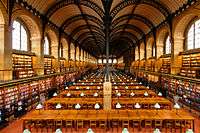Henri Labrouste
| Henri Labrouste | |
|---|---|
 | |
| Born |
11 May 1801 Paris |
| Died |
24 June 1875 (aged 74) Fontainebleau |
| Nationality | French |
| Occupation | Architect |
| Awards |
Prix de Rome 1824 |
| Projects | Bibliothèque Sainte-Geneviève |
Pierre-François-Henri Labrouste (French: [pjɛʁ fʁɑ̃swa ɑ̃ʁi labrust]) (11 May 1801 – 24 June 1875) was a French architect from the famous École des Beaux-Arts school of architecture. After a six-year stay in Rome, Labrouste opened an architectural training workshop, which quickly became the center of the rationalist view. He became noted for his use of iron-frame construction and was one of the first to realize the importance of its use.
Biography
Born in Paris, Labrouste entered the Collège Sainte-Barbe as a student in 1809. He was then admitted into the second class and the Lebas-Vaudoyer workshop in the École Royale des Beaux Arts in 1819. In 1820, he was promoted to the first class. Competing for the Grand Prix, Labrouste took second place behind the Palais de Justice by Guillaume-Abel Blouet in 1821.

In 1823, he won the departmental prize and worked as a lieutenant-inspector (sous-inspecteur) under the direction of Étienne-Hippolyte Godde during the construction of the Saint-Pierre-du-Gros-Caillou parrish in Paris. A turning point in Labrouste's life occurred in 1824, when he won the competition with a design of a Court of Appeals (Cour de cassation). In November, he left Paris for Italy, visiting Turin, Milan, Lodi, Piacenza, Parma, Modena, Bologna, Florence and Arezzo.
Stay in Rome

Receiving a pension or stipend from the French government for five years, he and the other Académie française laureates stayed in the Medici Villa in Rome. The directors of the Académie stated in correspondence in French about the laureates that, in their studies of antiquity, they "must research the laws of proportion and reduce them to formulas to be used by masters and students in Paris."[1]
His work was the subject of "Henri Labrouste: Structure Brought to Light," the first solo exhibition in the U.S. of his work, at The Museum of Modern Art in New York City.[2][3]
His buildings include:
- Bibliothèque Sainte-Geneviève, Paris, and built between 1843 and 1850
- The Salle Labrouste, a reading room in the Bibliothèque Nationale de France in the Rue de Richelieu, Paris, and built between 1862 and 1868
References
- ↑ Correspondance des directeurs de l’Académie de France à Rome, tome 1, p. 28
- ↑ Corinne Bélier, Barry Bergdoll and Marc Le Coeur, Henri Labrouste: Structure Brought to Light, New York: The Museum of Modern Art, 2013
- ↑ "Henri Labrouste: Structure Brought to Light". moma.org. March 10, 2013. Retrieved March 23, 2013.